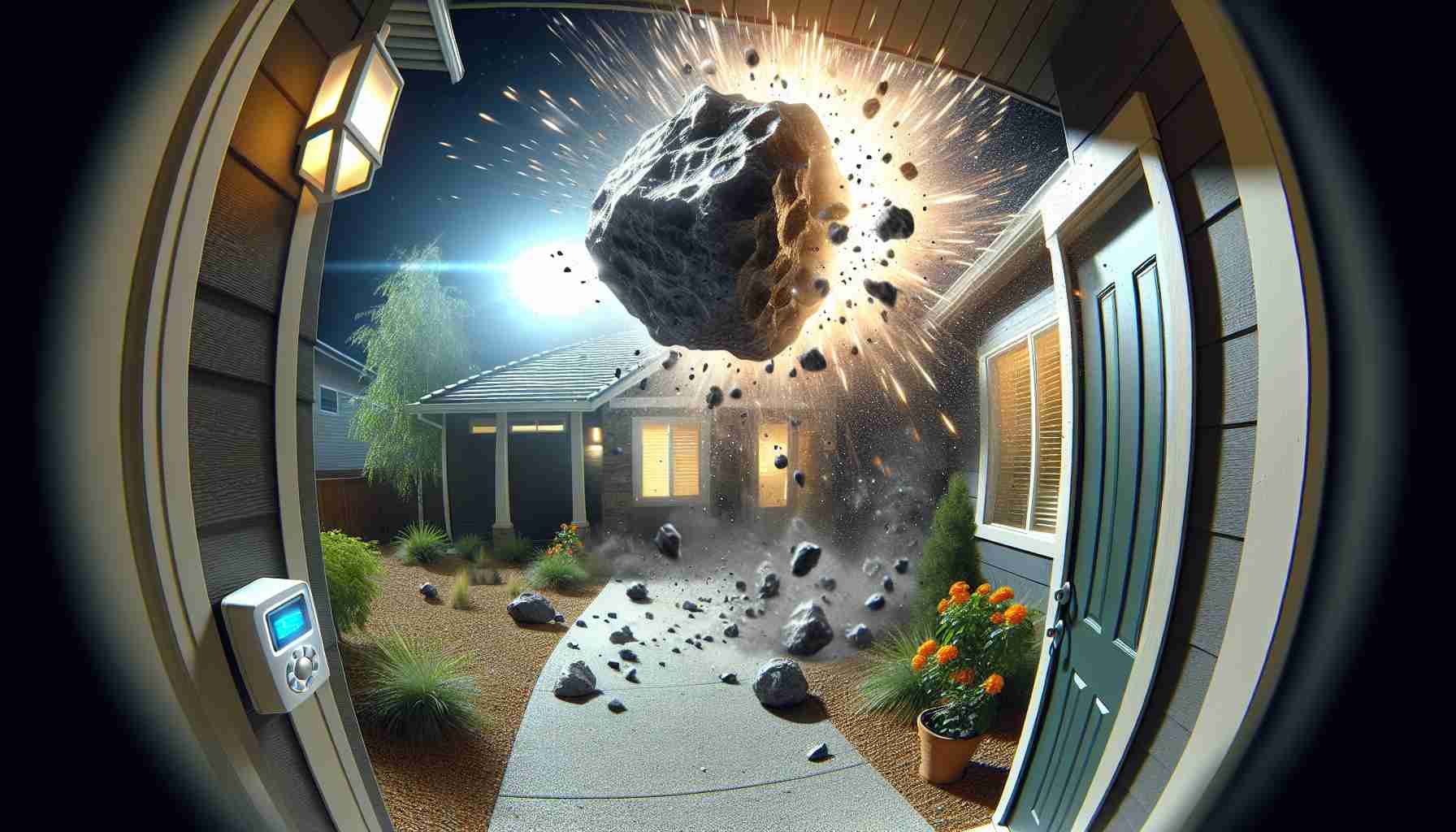The Extraordinary Encounter With Space.
A Canadian couple experienced a cosmic phenomenon firsthand when their doorbell camera recorded an incredible event: a meteorite landing on their property. After enjoying a leisurely evening stroll in July, Laura Kelly and her partner were astonished to find their walkway covered in fine dust and unfamiliar debris. Their curiosity led them to review their security footage, revealing a dramatic scene: a bright object hurtling toward their home, followed by a burst of smoke and distinctive crackling sounds.
Intrigued by their discovery, they promptly reported the incident to the University of Alberta’s Meteorite Reporting System. Chris Herd, the curator, examined the debris and confirmed its extraterrestrial origin. These space rocks, known as meteorites, enter the Earth’s atmosphere daily, with an estimated 48 tons making contact each day, according to NASA. Though they frequently disintegrate as meteors, often seen streaking through the night sky during meteor showers, landing on a front walkway is exceptionally rare.
This incident marks a significant moment in meteorite observation, as it is uncommon to capture audio and video of a meteorite strike in such detail. The meteorite, which has now been officially registered, has been named Charlottetown, in honor of its landing site on Prince Edward Island in Canada.
The Cosmic Encounter: A Reflection on Society and the Future
The extraordinary encounter with a meteorite in Canada transcends mere curiosity; it embodies our collective relationship with the cosmos. Every day, approximately 48 tons of space debris enters Earth’s atmosphere, but events like the one witnessed by Laura Kelly and her partner remind us of our vulnerability and connection to a universe filled with wonders and dangers. This incident not only serves as a wake-up call to aerospace enthusiasts but also highlights the potential for increased public interest in astronomy and space exploration.
Furthermore, it raises questions about how we perceive and interact with space. As more people become aware of cosmic phenomena, there may be a shift in cultural narratives surrounding our place in the universe. Increased media attention on such occurrences can inspire a future generation of scientists, engineers, and environmentalists, fostering a societal shift towards greater STEM engagement.
From an environmental perspective, the implications of meteorite impacts are profound. While individual events like the one in Canada might seem isolated, the cumulative effect of meteorites on our planet could influence global ecological systems over time. Additionally, as we explore potential strategies for resource extraction from asteroids, the ethical considerations of space mining might come into sharper focus.
In light of the incident named Charlottetown, a new cycle of interest in meteorite studies could lead to improved methods for tracking and studying celestial objects. As technology evolves, so too do our capabilities in monitoring and responding to cosmic events, hinting at a future where humanity may harness space not just for exploration but also for sustainable use.
Astonishing Meteorite Strike Captured by Doorbell Camera: What You Need to Know
An Unprecedented Meteorite Encounter
In a remarkable event that has captivated both the scientific community and the public, a Canadian couple unwittingly recorded a meteorite landing on their property. Laura Kelly and her partner were enjoying a calm evening stroll in July when they returned home to discover unusual remnants scattered across their walkway. Their doorbell camera footage unveiled a vivid and extraordinary scene: a bright object streaking toward the ground, followed by a cloud of smoke and distinctive crackling sounds.
The Meteorite’s Journey
Upon realizing the significance of their discovery, the couple contacted the University of Alberta’s Meteorite Reporting System. Specialist Chris Herd examined the debris, confirming that it was indeed a meteorite. This finding is particularly noteworthy since, while meteorites enter Earth’s atmosphere in significant quantities—an estimated 48 tons daily, as reported by NASA—actual landings are rare and seldom captured so vividly on video.
Insights on Meteorites
What is a Meteorite?
Meteorites are fragments of asteroids or comets that survive their fiery passage through the Earth’s atmosphere and land on the planet’s surface. They provide valuable insights into the solar system’s formation and the materials that constitute it.
Frequency of Meteorite Landings
NASA states that while many meteoroids enter the atmosphere, most disintegrate before reaching the ground, creating spectacular light shows known as meteors. It is estimated that around 17 meteorites larger than a kilogram reach Earth every year. The Charlottetown meteorite, being an exception, offers a unique opportunity to study a specimen that landed intact.
The Significance of the Charlottetown Meteorite
Now officially registered and named after its landing site in Charlottetown, Prince Edward Island, this meteorite represents a significant opportunity for research. The registration of such an event not only helps track meteorite occurrences but also opens avenues for further studies regarding composition, origin, and the implications for understanding planetary formation.
Frequently Asked Questions (FAQ)
Q: What should I do if I think I’ve found a meteorite?
A: If you suspect you’ve discovered a meteorite, contact a local university or meteorite expert. They can help determine the object’s origin.
Q: How can I identify a meteorite?
A: Look for a rock that is dense, metallic, and has a fusion crust—a shiny exterior formed by its journey through the atmosphere.
Q: Are there any risks associated with meteorite landings?
A: Although rare, meteorite impacts can pose risks. Most, however, land in unpopulated areas.
Conclusion: A Cosmic Connection
The Charlottetown event is a reminder of humanity’s connection to the universe and how cosmic events can bridge the gap between the known and the unknown. As we continue to explore space and its mysteries, observations like this enhance our understanding of the universe’s workings. For more stories about space and scientific discoveries, visit NASA.
